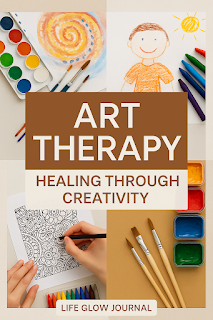Art Therapy: Healing Through Creativity
Published by Life Glow Journal | Updated July 2025
Introduction to Art Therapy
Art therapy is a form of expressive therapy that uses the creative process of making art to improve a person’s physical, mental, and emotional well-being. It integrates psychotherapeutic techniques with the creative process to promote healing and self-expression. In today’s fast-paced world, art therapy offers a calming, introspective way to manage stress and emotional health.
The Science Behind Art Therapy
Neuroscience supports that creative expression through art can enhance brain function, lower cortisol levels, and even stimulate dopamine production. Research shows that engaging in artistic activities can activate the reward system in the brain, improve cognitive functions, and promote emotional resilience.
Emotional & Mental Health Benefits
- Reduces stress and anxiety
- Improves emotional regulation
- Helps process trauma and grief
- Increases self-esteem and confidence
- Supports mindfulness and relaxation
Techniques Used in Art Therapy
Art therapists may use a range of techniques depending on individual needs:
- Painting & Drawing: For emotional expression
- Collage & Mixed Media: For storytelling and introspection
- Sculpting: For tactile release and grounding
- Mandala Creation: For meditation and mindfulness
- Zentangle & Pattern Work: For focus and anxiety relief
Who Can Benefit from Art Therapy?
Art therapy isn’t limited to artists or children; it’s for anyone dealing with emotional challenges, including:
- People with depression or anxiety disorders
- Veterans with PTSD
- Children with behavioral disorders
- Individuals recovering from trauma or loss
- People managing chronic pain or illness
Art Therapy in Clinical Settings
Art therapy is widely used in hospitals, psychiatric facilities, schools, and rehab centers. Many mental health clinics integrate art therapy with traditional psychotherapy to enhance communication and healing.
DIY Art Therapy Activities to Try at Home
- Draw how you feel each morning and evening
- Create a visual gratitude journal
- Paint your dreamscape
- Design a collage of future goals
- Use adult coloring books for relaxation
Product Recommendations
Try these therapeutic art tools and workbooks at home:
- 🎨 US Art Supply 143-Piece Art Set – All-in-one starter set for creative therapy.
- 📔 Creative Therapy Coloring Book for Adults – Mindful coloring to relax your mind.
- 🧠 Mindful Art Therapy: A Self-Care Workbook – Guided prompts for emotional healing.
- 📱 Skillshare Online Art Therapy Classes – Explore your creativity with professionals.
Success Stories and Testimonials
“Art therapy helped me express what I couldn’t say in words. It was the key to unlocking my recovery journey.” – Sarah, 32, trauma survivor.
“After losing my job, painting gave me a reason to wake up and feel hopeful again.” – James, 45, battling depression.
Becoming an Art Therapist
To become an art therapist in the U.S., you’ll typically need a master's degree in art therapy, national board certification, and state licensing. Fields like psychology, social work, or education can offer a pathway into this creative profession.
Related Posts You Might Like:
- Exploring Sculpture: Ancient to Modern
- The Power of Political Art
- Top Art Festivals Around the World
- Basic Coding Tutorials for Beginners
Conclusion
Art therapy offers more than just artistic expression; it provides a powerful tool for emotional healing and personal growth. Whether you're facing mental health challenges or seeking self-care practices, tapping into your creative side can be the beginning of your healing journey.
FAQs About Art Therapy
What is art therapy?
Art therapy is a type of psychotherapy that uses art media as its primary mode of communication, useful for exploring emotions, reducing anxiety, and boosting self-esteem.
Can anyone do art therapy?
Yes, art therapy is beneficial for individuals of all ages and does not require any prior art experience.
Do I need an art therapist to start?
No. While guided therapy with a licensed professional is recommended for deep issues, many people start with simple activities like coloring or journaling at home.
Is art therapy evidence-based?
Yes, many clinical studies support the mental and emotional benefits of art therapy, including reduction in cortisol and improvements in mood.
🧩 What's Next?
If you found this helpful:
- Share
it on WhatsApp or social media
- Subscribe
to our newsletter
- Comment
below: What’s your favorite ?
📢 Affiliate Disclaimer
This post contains affiliate links. If you purchase through these links, I may earn a small commission at no extra cost to you. This helps support the blog and allows me to create more helpful content for you. Thank you

Post a Comment